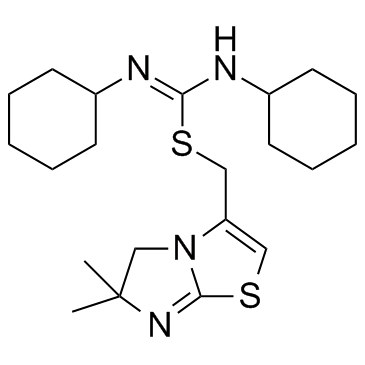864677-55-4
| Name | IT1t |
|---|---|
| Synonyms |
(6,6-Dimethyl-5,6-dihydroimidazo[2,1-b][1,3]thiazol-3-yl)methyl N,N'-dicyclohexylcarbamimidothioate
Carbamimidothioic acid, N,N'-dicyclohexyl-, (5,6-dihydro-6,6-dimethylimidazo[2,1-b]thiazol-3-yl)methyl ester |
| Description | IT1t is a potent CXCR4 antagonist; inhibits CXCL12/CXCR4 interaction with an IC50 of 2.1 nM. |
|---|---|
| Related Catalog | |
| Target |
CXCL12/CXCR4:2.1 nM (IC50) HIV-1 (X4):14.2 nM (IC50, in MT-4 cells) HIV-1 (X4):19 nM (IC50, in PBMCs) |
| In Vitro | The CXCR4 is involved in chemotaxis and serves as a coreceptor for T-tropic HIV-1 viral entry and in cancer metastasis. IT1t is a small, drug-like, isothiourea derivative. IT1t shows very potent and dose-dependent inhibition of the CXCL12/CXCR4 interaction with an IC50 of 2.1 nM. This calcium flux is also inhibited by IT1t with an IC50 of 23.1[1]. Strong electron density is observed for IT1t in the binding cavity of both subunits of the CXCR4 homodimer. In dimers of CXCR4 bound to IT1t, the monomers interact only at the extracellular side of helices V and VI, leaving at least a 4 Å gap between the intracellular regions, which is presumably filled by lipids. The IT1t compound and CVX15 peptide have both been characterized as competitive inhibitors of CXCL12, and many of the receptor-ligand contacts in the co-crystal structures presented are important for CXCL12 binding, including the acidic Asp187, Glu2887.39 and Asp972.63. The binding site of IT1t may point to the major anchor region for this domain[2]. |
| In Vivo | IT1t reduces the formation of TNBC early metastases in the zebrafish xenograft model. Tumor cell invasion at the metastatic site is effectively reduced upon CXCR4 silencing (Fig. 7B), similar to the antagonist IT1t [3]. |
| Cell Assay | Jurkat cells are incubated with serial dilutions (0.001, 0.01, 0.1, 1, 10, 100, 1000 μM) of IT1t at room temperature for two hours. Cytotoxicity of IT1t is also evaluated at 37°C over a longer period of time in MT-4 cells and PHA-stimulated PBMCs (ten day incubation) because these cell types are used in anti-HIV activity assays which last up to ten days. Cytotoxicity is evaluated microscopically and viability is assessed using the a kit[1]. |
| References |
| Density | 1.3±0.1 g/cm3 |
|---|---|
| Boiling Point | 529.8±60.0 °C at 760 mmHg |
| Molecular Formula | C21H34N4S2 |
| Molecular Weight | 406.651 |
| Flash Point | 274.2±32.9 °C |
| Exact Mass | 406.222473 |
| LogP | 6.16 |
| Vapour Pressure | 0.0±1.4 mmHg at 25°C |
| Index of Refraction | 1.675 |
